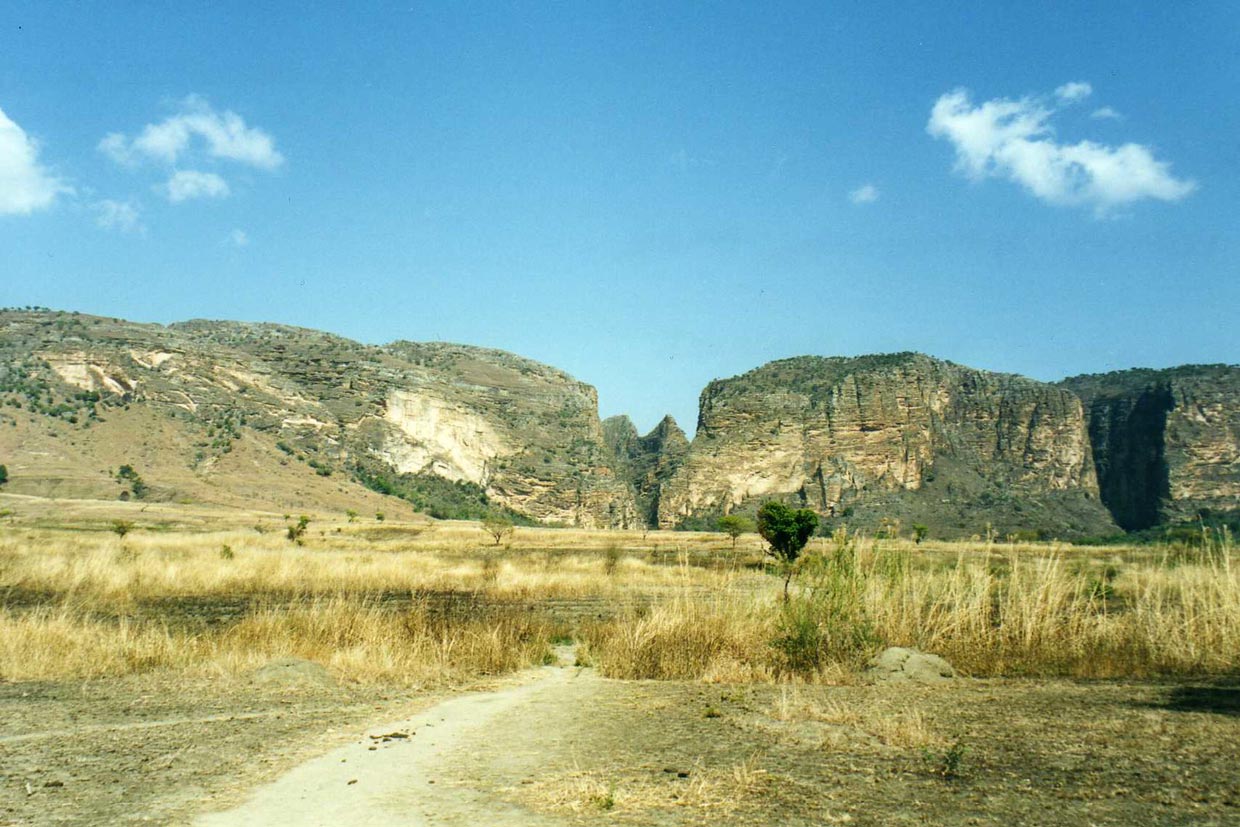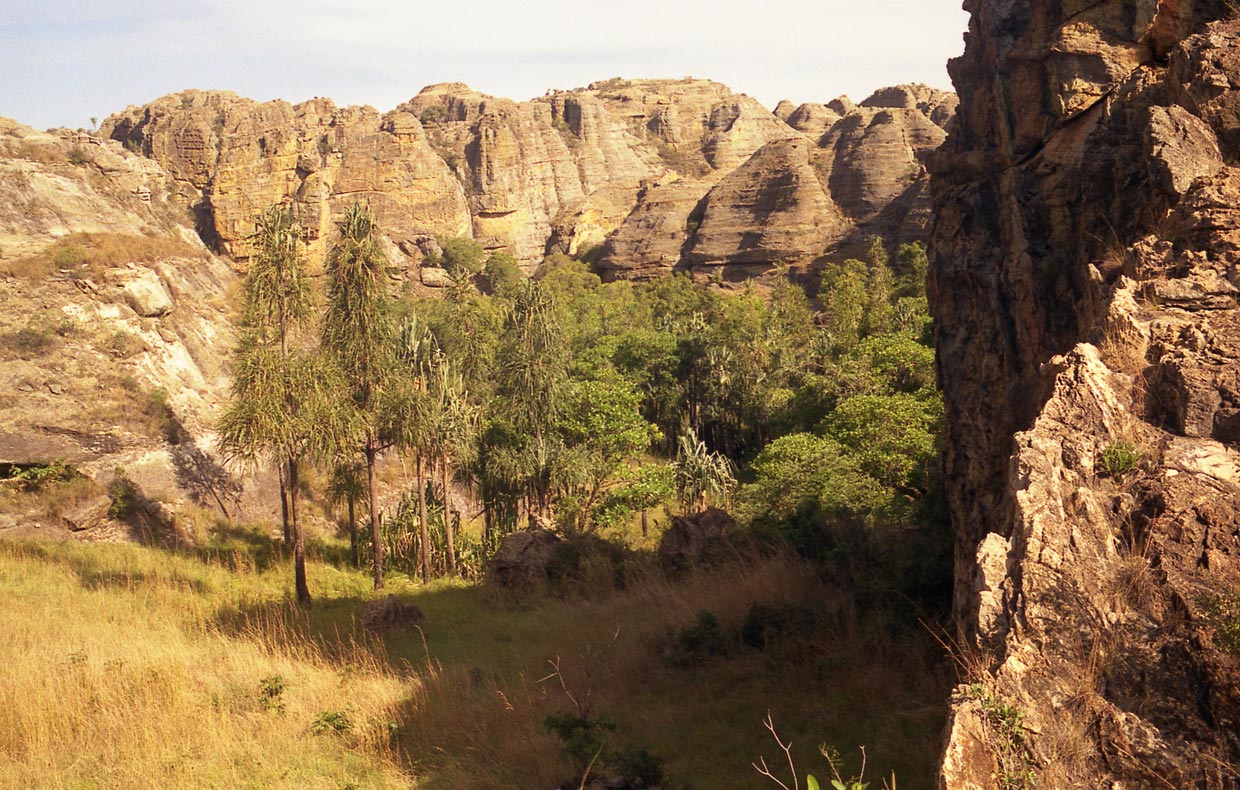Madagascar‘s most visited natural park, Isalo National Park, is located amidst the Jurassic-era highlands of the country’s southwest. Isalo, established in 1962, offers sweeping landscapes, pure raw nature, and paradisiacal natural pools. It can surprise you by over 80,000 hectares of land dominated by a stunning eroded sandstone massif and a tremendous variety of plateaus, canyons up to 200 meters deep, gorges, and pinnacles.
What to Do in Isalo Park?
Strolling through this natural rock massif, you will not get bored between deserted landscapes and verdant canyons. Visitors can go on the rocks along the small streams or dip in the blue pool to fresh up during excursions. However, be careful about taking a bath in the black pool because the water is frozen. Nevertheless, the black pool is still worth a visit.
The highlighted part is the Isalo window, a window whose frame is made of the boulder. You will make an unforgettable memory by observing one of the most beautiful sunsets of your life. Let yourself be tempted by hiking that lasts from a few hours to a few days to complete, which is the main thing to do for visitors of Isalo. Make sure you have the perfect pack for hiking, including a hat, sunscreen, water (You will need more than you think), and hiking shoes.
A tour to the canyon of Namaz is also an excellent choice. By walking through the Namaza gorge, You will lead to Piscine Noire and Piscine Blue, natural pools, and waterfalls.
Fauna and Flora
The diversity of species in Isalo is so great that 116 medicinal species and timber for furniture and handicrafts can be found. You are enjoying watching around, which looks very desert_like, then all of a sudden, palm trees appear. This type of variety is unlikely to be found in other places.
Travelers can also find the Elephant Foot plant because it is visible in much of the park, mostly on the side of cliffs; its lively yellow flowers make it more attractive. If you look around the plateaus, you can see another common site, the aloes. We conclude by promising that you will set foot in Isalo on a carpet of the “Tapia,” food of “Landibe.”

Animals of Isalo
There are plenty of fascinating animals to see in Isalo National Park. Let’s mention fascinating mammals like the foss, two species of tenrec, and two civet species. Isalo National Park is a safe house for no fewer than 14 lemur species. It’s almost guaranteed you can take great photos of ring-tailed lemurs because they are intimate with humans.
It is important to note that among the 77 species of birds, of which 27 are endemic to Madagascar, make sure to find the Benson Rock bill since they only live here. You will also have a chance to visit many other animals such as rock reptiles, giant eels, and crocodiles!
When to Go
Isalo is quite hot, and it’s unlikely to find shadow. So the climate is suitable to visit year-round because of the dry climate and the lack of rain. Happily, you don’t need to worry about massive downpours. If you plan on traveling from July to August and December, it is recommended to book your accommodation earlier, as this time is the peak tourist season.
The temperature in Isalo frequently exceeds 87 °F/30°C around the year, so you need to protect yourself with sunscreen, a hat, light clothing, and plenty of water.
Isalo National Park Weather Information
[wpsm_colortable color=”main-color”]
| Month | Jan | Feb | Mar | Apr | May | Jun | Jul | Aug | Sep | Oct | Nov | Dec |
|---|---|---|---|---|---|---|---|---|---|---|---|---|
| High (°C) | 29 °C | 29 °C | 29 °C | 28 °C | 24 °C | 24 °C | 24 °C | 26 °C | 28 °C | 30 °C | 31 °C | 30 °C |
| Low (°C) | 18 °C | 18 °C | 17 °C | 15 °C | 13 °C | 10 °C | 10 °C | 11 °C | 13 °C | 15 °C | 17 °C | 18 °C |
| High(°F) | 84 °F | 83 °F | 84 °F | 83 °F | 79 °F | 75 °F | 74 °F | 78 °F | 83 °F | 86 °F | 87 °F | 85 °F |
| Low(°F) | 65 °F | 65 °F | 63 °F | 60 °F | 55 °F | 51 °F | 50 °F | 51 °F | 55 °F | 59 °F | 63 °F | 64 °F |
[/wpsm_colortable]

How to Get There?
If you want to enter the Isalo National Park, you have to go through the town of Ranohira. The nearest big cities are Toliara (about 240 kilometers to the southwest) and Fianarantsoa ( a bit more than 270 kilometers to the northeast). Accessing to Isalo is manageable by all three settlements connected by the RN7, Madagascar’s biggest and best-maintained road.
You have to drive about 15 hours along the RN7 from Antananarivo, Madagascan capital, to Isalo. It is possible to rent a car to get to Isalo, but you have to rent both a car and a Madagascar driver.
Stopping along the way at Ranomafana National Park and the ex-colonial city of Antsirabe is a good idea. Driving back to Ranomafana from Ranohira takes a full day, around 9 or 10 hours.
If you would like to fly, there are daily flights from Tana to Toliara; and from there, by renting a vehicle or taking a taxi brousse, you can get to Isalo in about 3 hours. Taxi brousses are basically over-sized vans that are quite cramped but will get you around.
How to Visit?
No matter whether you are traveling as a part of a planned Madagascar tour or not, it is easy to visit Isalo National Park even independently. For paying some necessary costs like entry fees, book accommodation as well as hiring guides and porters, you should go to the park office, located in the nearby village of Ranohira.
Hiring a local guide isn’t optional, and you should hire one. The fees change based on which trail you choose. All guides speak French, and some speak English. Also, It can be helpful and a rare experience to hire 4×4 vehicles and drivers to take you quickly to the road heads. Otherwise, you have to walk for about one and a half hours. The park office starts working after 6:30.
You might get interested in the region’s geological and cultural heritage by visiting Maison de l’Isalo. It is a good idea to visit this small museum located just south of Ranohira in the small village of Zahavola before heading into Isalo National Park. You can see the museum between 6:30 a.m. to 6 p.m.

Where to Stay?
There are different accommodation options in Isalo National Park, helping you have a wide range of options depending on your budget, preferences, etc.
Hotel H1 ISALO
Hotel H1 ISALO is a great budget-friendly choice, located just outside of Ranohira. The great price and a restaurant on-site and basic but clean and bright rooms make you satisfied by your decision.
Isalo Rock Lodge
If you prefer more luxurious experiences, Isalo Rock Lodge is the best option, located outside the village. Suppose you are a fan of outdoor pool bars, gorgeously decorated rooms, a private balcony overlooking the park’s magnificent rock formations, and renting a bike. In that case, this place will be excellent for you. Give it a chance, and the experience would be everlasting.
Le Jardin du Roy and Relais de la
You can also choose one of two Le Jardin du Roy and Relais de la hôtels, which offer stone bungalows, lush grounds, and horseback riding. These places belong to local people who are friendly and let you experience a local’s life.
Basic but Enough
If you want to feel something different and more related to the park atmosphere, what is better than camping? There are two large campsites within the park with basic facilities, including shared toilets, shower, and barbecue facilities.





